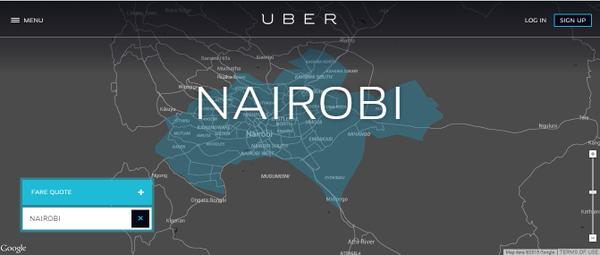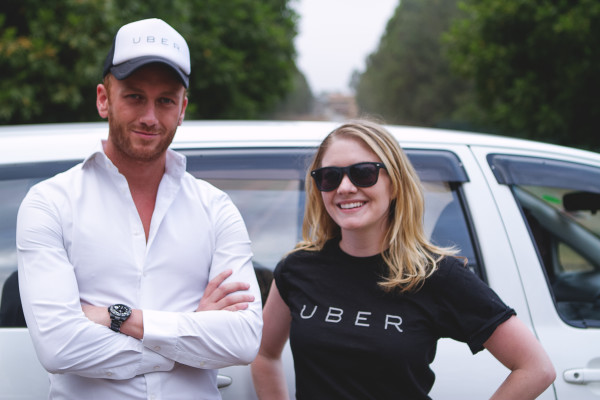Uber’s foray into the African continent began in South Africa in 2012 with the launch of their service in Johannesburg and later in Cape Town and Durban. There were rumours that Kenya would be the second country that they would set up in. This was mostly fueled by the fact the country has a high Internet penetration rate and a large expatriate community thanks to the UN agencies, multinationals and foreign commissions it hosts. Be that as it may, the second country Uber ventured into in Africa was Lagos, Nigeria in 2014.
The rumours of a Kenya launch were restarted in late 2014 courtesy of a job ad on LinkedIn and on their website searching for Uber staff in the Kenyan market. The job ad caught the attention of Kenyans and Capital FM’s Ken Macharia did an article on it. They were looking for key staff and among them was the position of a General Manager. The company didn’t confirm when it was launching and emails to their PR just elicited a standard response.
Thank you for getting in touch and for your interest in Uber.
We are excited to be looking at testing our technology in Nairobi, working towards offering a safe and reliable transport option.
We are still in the beginning phases, so please bear with us for the next few weeks.
Venturing into the Kenyan Market
The Kenya launch finally came to be on January 21st 2015. It was a soft launch with a post on the Uber blog and on various Kenyan and International websites further fueling the existence of the service in Nairobi. The Uber blog post featured fashion blogger Sharon Mundia, entrepreneurs Mbugua Njihia and Harry Hare using the Uber app to get taxis in Nairobi. Kenyan users got a 20% discount for the first two weeks after launch. Uber partnered with Kenyan restaurant discovery platform EatOut to offer free rides to new users attending the Nairobi Restaurant Week 2015. The discount and promo codes pushed sign-ups to the platform and users who discovered Uber this way ended up being hooked to the service. The Uber pricing was a hit with newbie users. Most people ended up paying half what they normally paid to Kenyan taxis while using the taxi service hence increasing uptake due to word of mouth recommendations.
The soft launch was spearheaded by International launcher Alastair Curtis, assisted by Kaitlin Freedman (operations manager) and the Africa office based in South Africa. Part of their responsibility was to recruit companies that would bring their cars into the Uber ecosystem. It has never been confirmed by the company or its representatives how many cars and drivers they started with in Nairobi. However, from asking some of the pioneer drivers I got a figure of 10 cars and 20 drivers. The drivers would work in 12 shifts and ‘share’ a car. Some preferred to work for 24 hours and hand over to the second driver who would also work the same hours as they rested. This practice continues to this day for those drivers that share a car.
Uber and Kenyan Banks
Kenyan banks did not seem to be aware that Uber was launching in Kenya and that the service would employ the use of debit and credit cards. Most banks blocked any charges by Uber BV when their customers tried to use their cards on Uber. Uber BV, based in Netherlands, is the subdsidiary company Uber uses in this Europe and Africa. Most debit cards have not worked on the Uber app to date. A popular answer to the question of why some Kenyans cards weren’t working on the Uber platform on the Uber Kenya Twitter account was that, to paraphrase, “it’s your bank’s fault, kindly contact them about it”. Most credit cards worked with the Uber system but debit cards were a challenge.
@uber_kenya Here’s a snapshot of what’s going on on my side. With the pepea card. pic.twitter.com/5VJVOkccfO
— Cranberry Love (@_eknock) May 5, 2015
Prepaid cards were especially affected and the top three prepaid cards i.e. Nakumatt Global, Nation Hela and the Naivas Reward Card did not work on Uber. Some users were able to register for the service using the prepaid cards but could not transact once the promotional codes expired. With 12 million debit cards and 451,944 prepaid debit cards against 186,634 credit cards in the Kenyan market, when Uber launched, one would have expected the company to pay more attention to the former.
@uber_kenya trying to request for a cab and I’m getting this error. It’s a Nakumatt Global Card. pic.twitter.com/74ogbhKMFO — The Devil’s Disciple (@sonnienjoki) April 2, 2015
A constituency that was more elated by the launch of Uber in Kenya was the expatriate community. They had foreign bank accounts, credit cards and had already used the app in their home country. A common complaint among them before Uber came into the picture was that Kenyan taxis had a tendency to overcharge them. Uber, with its transparent pricing system, was very appealing to them. Because of this, they welcomed the launch of Uber here with open arms. Uber gained traction in Nairobi faster than Lagos partly because of this. Kenyans who had experienced Uber before in other countries also drove usage and adoption of the app.
@uber_kenya are we charged from local banks or do we have to suffer exchange rates? This is overseas transaction. pic.twitter.com/0xPxwb9mKp
— Shukri Nunow (@ShukriNunow) January 23, 2015
There were those that were skeptical about Uber’s ability to penetrate this market. Technology writer Kennedy Kachwanya was of the opinion that Uber would struggle in Kenya especially around payments since it only accepted credit cards and some debit cards. Daily Nation contributor Akello Arunga on her part argued that Uber should never have been allowed to enter the Kenyan market entirely after a rape incident in New Delhi that involved an Uber driver. Kachwanya would later meet Alastair and Kaitlin, at their request, after he published his article and his summary of them was that;
“They are not nice people. They claimed my article was innacurate but they could not substantiate their arguments. I doubt their competency as custodians of the Uber brand in this market”
Despite the job ad in late 2014 Uber did not hire a Kenyan to join its team here in the early days. All indications pointed to Alastair and Kaitlin being the drivers of the Uber brand in Kenya. Alastair, a South African, had previously launched Uber in Nigeria and did not seem to have previous Kenyan experience. Kaitlin, an American, did not also have any prior Kenyan experience. This might have worked against Uber especially on the payments front. An addition of someone to the team with local knowledge and connections would have really helped guide Uber in Kenya especially in the beginning.
Official Uber Launch
Uber officially launched in Kenya in June 2015. The launch coincided with the introduction of cash payments. Users still needed an accepted debit card or credit card to register for the service. This made the cash payments a bit redundant. According to technology blogger Moses kemibaro, “UberCASH has not resulted in as many new customers as expected”.
The issues with the cards became worse after the official launch and some debit cards that were working before stopped and haven’t worked since. Some users owe Uber for trips taken just before their cards stopped working on Uber. They are unable to clear their debts because to do so one has to use a card (credit and some debit cards).
Other weak points in Uber’s foray into the Kenyan market include drivers, passenger safety, communication and marketing.
Uber Drivers
At a press briefing in February, Kaitlin shared how they pick drivers to join the Uber ecosystem. The drivers are required to have a PSV driver’s license, a certificate of good conduct and additionally, KK Security company conducts a background check on all successful applicants. A question that Kaitlin couldn’t answer however was specifically how the drivers are disciplined. Let’s say a user has a particularly bad experience, how sure are they that action was taken against the driver in question. I got a vague ‘just trust that action will be taken’ from Jambu Palaniappan, GM Eastern Europe, Middle East & Africa, when I posed the same question to him shortly after a press brief.
The concern here is that if a complaint is logged, Uber would just make sure that the user and the problematic driver would never cross paths and the user would never be any the wiser.
Passenger Safety
Passenger safety was always a concern when Uber launched in Kenya, especially after what happened in India. It however came to the fore when Wanjiru Wainaina shared her not so good experience in an Uber taxi. Except for assurances that Uber takes passenger safety seriously it was not clear what steps the company took to ensure that something like that never happened again. The company never released a statement and it is not clear if the driver was ever disciplined.
I asked Jambu if they plan to set up a passenger safety service in Kenya, his response, they’ll consider it but it’s not in the pipeline yet.
Customer Support
Uber’s customer support is imperfect at best and doesn’t seem to be handled by people who know this market or even where Kenya is. Some users have complained about getting the following message
“Most South African debit cards unfortunately do not work on the Uber system at the moment. You can load a cheque or credit card to the account. Alternatively, you can also make use of Uber even if you don’t have a credit or cheque card! VCpay is a mobile app that generates Mobile Virtual MasterCards®, which you can add as your payment option while signing up with Uber”.
Their Twitter account is of little help as the support procedure is to channel all issues via email.
Conclusion
The taxi industry in Kenya needed the kind of disruption Uber brought. They however don’t seem equipped to handle the market. If they are not careful they might find themselves being disrupted now that they have introduced a taxi model that Kenyans seem to trust.
In summary, here are the issues that Uber needs to take seriously in order to make any meaningful inroads into the Kenyan taxi market;
- Ensure that there is seamless integration with the most popular payment forms in Kenya be they M-pesa, debit cards or pre-paid cards
- Give better assurances on personal safety of passengers beyond the standard responses
- Carry out better background checks on the drivers and have elaborate discipline procedures that go beyond helping a bad driver avoid the same client twice.
- Have a local support team or at least one that understands local nuances that only Kenyan customers face.
- Have a Kenyan or someone with a very good understanding of the Kenyan Taxi business in the decision making team especially on matters to do with marketing, new product offerings & strategic partnerships.
[****Hat to tip to Njeri Wangari and Mark Kaigwa for help with the article.]




